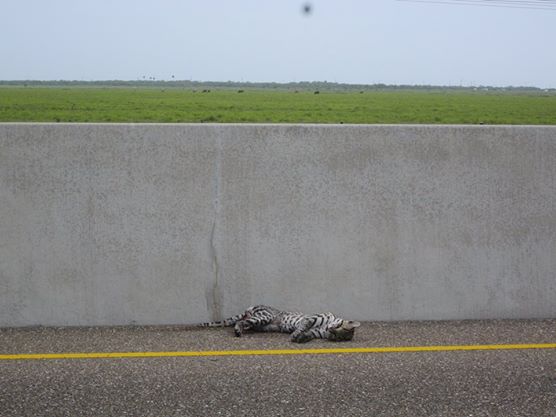

A male ocelot was killed on State Highway 100 between Laguna Vista and Los Fresnos last week, marking the fourth time a member of the endangered species has been killed by motor vehicle impact in the three years since
the concrete traffic barrier was built.
The cat was discovered by a local citizen, who reported the incident to the U.S> Fish and Wildlife Department (FWD). The ocelot was found along the concrete traffic barrier with injuries that are consistent with a vehicular collision, according to a news release sent last week by the Laguna Madre Atascosa Wildlife Refuge. The Refuge regularly monitors 12 ocelots, including the one that was killed last week. “The loss of this ocelot is significant in that he (represents) 20 percent of the current breeding male population at the Refuge,” the news release said. “We believe the concrete barrier is contributing to the increase in ocelot deaths by vehicles in this area,” said Refuge Manager Boyd Blihovde. “Many animals will not, or cannot, jump them, get trapped on the road and pose a danger to drivers and themselves. We have been working with the Texas Department of Transportation (TxDOT) on constructing wildlife crossings, but clearly more needs to be done.”
For the wild population to stay healthy and genetically diverse, ocelots from the Refuge need to travel and meet up with ocelots from other populations. Crossing roads and highways can be a deadly hazard for the cats.
The news release explained that scientific studies have shown that a wildlife crossing – an under-the-road passage with fencing to funnel animals to it – can be very effective at keeping wildlife off roads. “Crossings have been successful in south Florida where vehicle collisions with endangered panthers were a huge threat to their existence,” according to the news release. “Locally, an existing wildlife crossing on State Highway 48, near the Refuge’s Bahia Grande Unit, has been used by bobcats, raccoons, and coyotes.”
Zone Biologists Mitch Sternberg further emphasized the need for the concrete barrier to be replaced by enhanced wildlife crossings. “Under-road wildlife crossings can play an important role in alleviating unnecessary ocelot deaths,” Sternberg said. “Because so few wild cats remain, losing one animal has a huge impact on the population. The crossings not only keep wildlife safe, but also the public.” Sternberg explained that the issue comes down to how much funding TxDOT budgets for building roads.
“(They) spend less on building less crossings, therefore they can build more roads,” Sternberg said. Sternberg also noted that once TxDOT budgets the funds necessary to redesign Highway 100, the district engineer can “determine, almost independently, where he spends his budget (and) they could start the process at his discretion.”
The local community plays an important role in keeping this endangered wild cat in the Rio Grande Valley. “The public can contribute to our knowledge of ocelots by watching for ocelots throughout the Valley,” Sternberg said. The public is encouraged to report any possible sightings to the Refuge by calling 956-748-3607, or after hours at 956-748-7520.
To learn more about ocelots in south Texas, visit the Refuge’s website or Facebook page.




